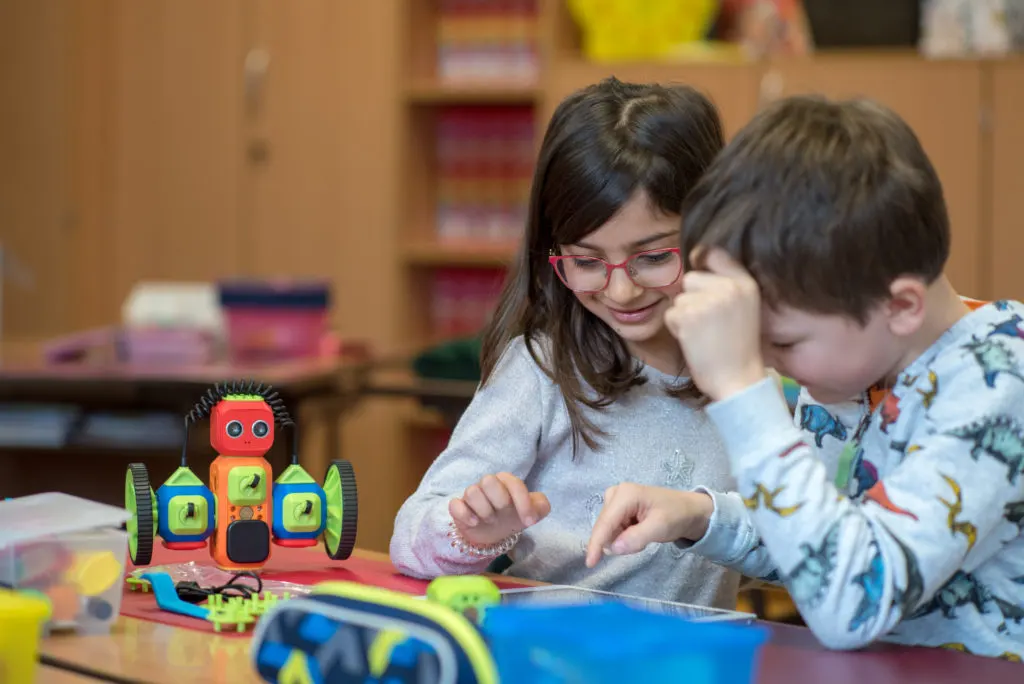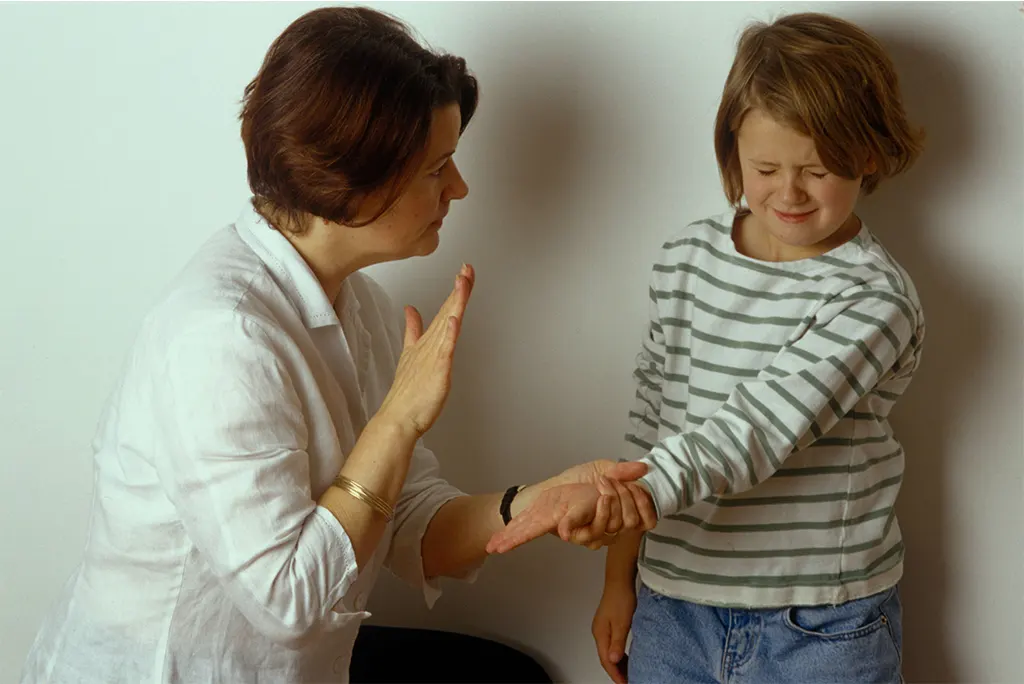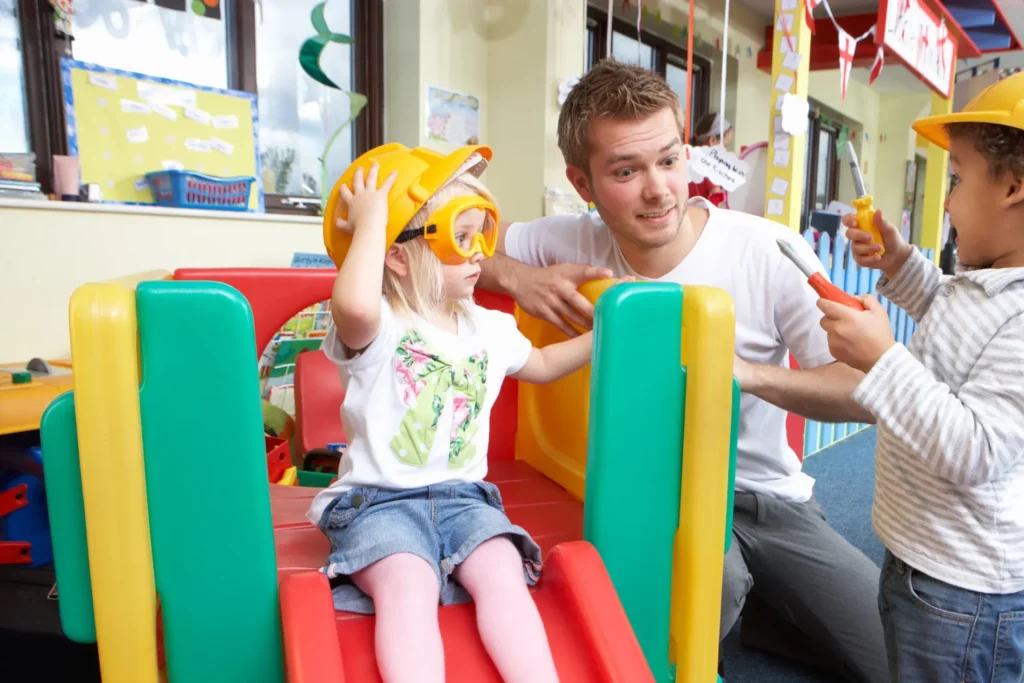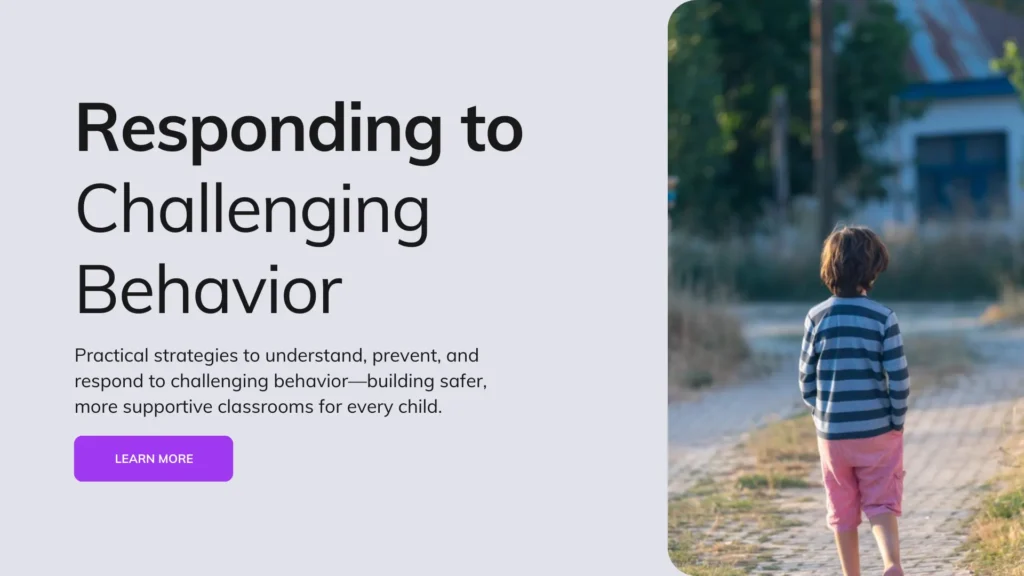Have you ever wondered why young children display challenging behavior such as tantrums, defiance, or social withdrawal? For many educators, managing challenging behavior feels overwhelming as it disrupts learning, routines, and relationships in the classroom.
Challenging behavior in early childhood often represents more than what we see on the surface. Behind the tears, the resistance, or the silence, there are stories of developing emotions, unspoken needs, and the growing pains of learning to navigate the world. These moments can feel disruptive, yet they carry within them the possibility of teaching empathy, resilience, and connection. For educators, the real challenge lies not in stopping the behavior but in understanding what it reveals and responding in a way that turns conflict into growth.
In this article, we’ll share smart solutions every educator needs to confidently address challenging behavior, foster a nurturing learning environment, and transform tough moments into stepping stones for growth.
What is Challenging Behavior in Early Childhood?
In early childhood, challenging behavior refers to a pattern of actions that consistently interfere with learning, social relationships, or safety, whether at home, in care, or in the classroom. While occasional misbehavior or emotional outbursts are developmentally expected, behavior becomes “challenging” when it is frequent, intense, or persistent across settings and significantly disrupts a child’s learning, the well-being of peers, or the overall classroom environment.
Chuck, a curious and energetic six-year-old, frequently showed behavior that went beyond age-typical missteps. In class he defied instructions and had intense tantrums when routines shifted. During recess, disputes sometimes escalated into fights, creating safety concerns and disrupting learning for peers. The pattern was frequent, intense, and persistent across settings, prompting a formal review by the school team. Chuck was then supported with an evidence-based plan, including a token-economy system at school and coordinated parent coaching at home through First Steps. Within weeks, incidents declined, engagement increased, and Chuck began forming positive peer relationships while keeping pace academically.
Source: CTE Case Studies PDF
Chuck’s story highlights how persistent defiance and aggression can disrupt both learning and safety. However, challenging behavior can take many other forms in early childhood, such as:
- Tantrums that are intense, prolonged, or occur multiple times a day
- Aggression, such as hitting, biting, or kicking peers or adults
- Persistent refusal to participate in classroom routines or follow directions
- Elopement or running away from adult supervision, creating safety risks
- Self-injury or repetitive behaviors that interfere with learning and development
- Extreme social withdrawal, where a child consistently avoids interaction with peers or teachers
The critical question educators must ask is: Does this behavior significantly interfere with the child’s learning, disrupt the classroom environment, or compromise safety? If the answer is yes, then the behavior can be considered “challenging” and requires intentional support and intervention.hen it falls under challenging behavior and requires a thoughtful response.

Reasons Children Engage in Challenging Behavior
Challenging behavior in early childhood is often a form of communication rather than intentional misbehavior. Since young children are still developing language, emotional regulation, and social skills, their actions frequently reflect what they cannot yet express in words. Below are four common reasons why these behaviors occur.
1. Unmet needs and the search for attention
Children may use behaviors like crying, yelling, or even aggression to signal that something important is missing. Sometimes the goal is positive attention, such as hugs or praise, while at other times even negative attention, like being scolded, feels rewarding because it ensures an adult is focused on them. For a child who lacks the words to ask directly, challenging behavior becomes the quickest way to feel noticed.
2. Avoiding or escaping difficult situations
Many children act out when they are presented with a task or situation that feels overwhelming, boring, or unpleasant. For example, refusing to sit for a worksheet, resisting bedtime routines, or throwing a tantrum during cleanup may all be ways of escaping. These reactions can be effective for the child if adults consistently remove the demand, reinforcing the behavior over time.
3. Limited skills for managing emotions and social situations
Challenging behavior often emerges when children do not yet have the tools to regulate strong feelings or navigate interactions. Without strategies for calming themselves, sharing with peers, or negotiating conflicts, they may resort to hitting, shouting, or withdrawing. In this sense, the behavior highlights a skill gap rather than willful disobedience.
4. Influences of internal and external factors
Physical and environmental conditions can also play a major role. Hunger, fatigue, or illness can lower a child’s tolerance and increase irritability. Likewise, environments that are overstimulating, chaotic, or too unstructured can lead to outbursts. Even big changes in daily routines, such as moving houses or a parent’s work shift change, may trigger anxiety that shows up as defiance or withdrawal. rather than frustration, turning disruptive moments into opportunities for guidance.
In short, challenging behavior is often a child’s way of communicating needs, avoiding stress, or coping with situations they cannot yet manage. By recognizing the underlying reasons, educators can respond with empathy and lay the groundwork for meaningful guidance and support.
Don’t just dream it, design it! Let’s chat about your custom furniture needs!
Why Educators Must Address Challenging Behavior?
Leaving challenging behavior unaddressed can create ripple effects that reach far beyond one difficult moment. For the child, unresolved behaviors can limit access to learning, hinder social development, and damage self-confidence. For classmates, frequent disruptions can reduce instructional time and strain peer relationships. And for educators, ongoing behavioral struggles can contribute to stress, fatigue, and burnout.

By addressing challenging behavior early and thoughtfully, teachers not only restore order to the classroom but also help children build critical life skills like emotional regulation, cooperation, and problem-solving. Each response to challenging behavior sends a message: “You are safe, your needs matter, and there are better ways to express yourself.” This consistency lays the groundwork for healthier relationships, smoother learning, and a more positive classroom climate overall.
How to address challenging behaviors
Challenging behavior in early childhood can feel overwhelming, but how educators respond determines whether the situation escalates or becomes a teaching moment. The most effective approaches move away from punishment and instead emphasize guidance, prevention, and skill building. By creating supportive environments and intentionally teaching new skills, educators help children learn how to manage emotions and interact more positively.
The difference between guidance and discipline
Although the words are often used interchangeably, guidance and discipline are not the same. Traditional discipline is usually linked with punishment, correction, or control. While it may stop a behavior temporarily, it often leaves children feeling rejected, embarrassed, or angry, which can worsen rather than resolve the issue.

Guidance, on the other hand, is a proactive and positive approach. It treats each conflict as a chance to teach, helping children understand expectations, learn self-control, and develop problem-solving skills. Building trusting relationships is essential: when children feel secure and respected, they are more receptive to adult guidance. In this sense, guidance looks forward, preparing children for success in the future, while discipline often looks backward, reacting to what already happened.
Tips for responding to challenging behavior
Effective responses to challenging behavior combine positive classroom management with intentional teaching of replacement skills. Below are some practical strategies:
Model choice and control
Show children that they have control over their actions and that choices carry consequences. Instead of only telling them what not to do, give clear alternatives so they understand how to behave appropriately.
Create calming spaces
Provide a safe, quiet corner where children can go when they feel overwhelmed. A “calm-down space” gives them time to process emotions, practice coping strategies, and rejoin the group when ready.
Turn negatives into positives
Respond to defiance with encouraging language. For example, rather than saying “Sit down,” try “Let’s save some energy for recess.” This avoids power struggles and keeps the relationship supportive.
Teach and reinforce positive behavior
Display visuals of classroom expectations, model positive actions, and lead discussions about how kind and cooperative behaviors make the environment better for everyone. Reinforce these behaviors with praise, high-fives, or privileges when children demonstrate them.
Use natural and logical consequences
If a child spills water on purpose, have them help clean it up. This response is instructive rather than punitive, helping children connect actions with outcomes in a fair way.
Minimize attention to problem behavior
During an episode, keep interactions brief and neutral. Providing too much attention—whether positive or negative—can unintentionally reinforce the behavior. Instead, redirect the child toward an appropriate alternative.
Focus on replacement skills
Dedicate most teaching time to showing children what to do instead of the problem behavior. For example, instead of grabbing, teach them to request a turn. Reinforce the new skill more often than the old behavior was reinforced, so it becomes the more effective option.
Stay consistent and collaborative
Consistency among all adults is key. When teachers, assistants, and caregivers respond in the same way, children know what to expect and feel secure. Writing down a plan and sharing it across the classroom team helps ensure everyone responds appropriately.
When educators replace punishment with guidance, pair responses with prevention strategies, and teach children the skills they lack, challenging behavior becomes an opportunity for growth. Over time, children learn how to regulate emotions, make better choices, and thrive in a safe, supportive classroom community.
Juanita, a quiet six-year-old, often avoided group activities and rarely spoke in class. Her teacher noticed this withdrawal was limiting her learning and social development. Instead of using reprimands, the teacher applied gentle guidance strategies: she praised Juanita for small steps, invited her into structured group work, and gave her calm spaces to regain confidence. Over time, Juanita began to interact more with her classmates, took part in group discussions, and even initiated conversations on her own. The progress showed how consistent guidance, positive reinforcement, and creating safe opportunities can transform challenging behavior into personal growth.
Source: CTE Case Studies PDF
Ineffective and Harmful Approaches to Discipline
While addressing challenging behavior requires patience and creativity, it also requires knowing what not to do. Certain approaches may stop misbehavior in the short term but cause long-term harm to a child’s development, emotional well-being, and trust in adults. These practices are not only ineffective but can also undermine the supportive learning environment educators work hard to create.

Physical punishment
Spanking, hitting, or any form of physical force has no place in early childhood education. Research shows it increases aggression, damages relationships, and teaches children that violence is an acceptable way to solve problems.
Shaming or humiliating
Using harsh words, yelling, or embarrassing a child in front of others may stop behavior temporarily, but it erodes self-esteem and creates fear rather than respect. Children learn best when they feel safe, not when they are shamed.
Withholding basic needs
Denying food, water, bathroom breaks, or rest as a punishment is harmful and inappropriate. These needs are fundamental to children’s well-being and should never be tied to behavior.
Isolation without support
While a calm-down space can be helpful, placing a child in isolation as punishment or leaving them unattended can be damaging. True guidance means staying connected, not cutting children off when they need help most.
Inconsistent or excessive punishment
Harsh or unpredictable discipline creates confusion and anxiety. Children need clear, consistent boundaries, not threats or consequences that feel unfair or overwhelming.
Don’t just dream it, design it! Let’s chat about your custom furniture needs!
When to Seek Professional Help for Challenging Behavior?
Most challenging behaviors in early childhood can be addressed with patience, guidance, and consistent classroom strategies. However, there are times when behavior signals a deeper need that goes beyond what educators can manage on their own. Knowing when to seek additional support is crucial for both the child’s well-being and the overall classroom environment.

Signs that extra help may be needed
- Persistence and severity: If a behavior happens frequently, is very intense, or lasts for weeks without improvement, it may require professional attention.
- Safety concerns: Behaviors that cause injury to the child or others, such as biting, head-banging, or running into dangerous situations, should not be ignored.
- Interference with learning: When challenging behavior consistently prevents a child from participating in daily routines or academic activities, intervention is necessary.
- Social isolation: If a child regularly withdraws from peers or is excluded due to their behavior, it may point to underlying difficulties.
- Regression: A sudden loss of skills the child had already mastered, like toilet training or language, may be a red flag.
Who can provide support?
- School counselors or psychologists can assess behavior patterns and recommend strategies tailored to the child.
- Speech and language therapists can help if communication struggles are contributing to frustration and acting out.
- Occupational therapists may assist with sensory challenges or self-regulation difficulties.
- Behavior specialists can work directly with teachers and families to create consistent intervention plans.
- Pediatricians or child psychiatrists can help rule out medical or developmental conditions.
How educators can help during the process
Seeking professional help doesn’t mean stepping back. Educators play a vital role in:
- Documenting observations with dates, frequency, and triggers of the behavior
- Communicating openly and respectfully with families about concerns
- Collaborating with specialists to ensure strategies are applied consistently across settings
How to prevent challenging behavior
Addressing challenging behavior is important, but preventing it from escalating in the first place is even more powerful. Prevention doesn’t mean eliminating every tough moment. Young children will always test limits as they grow, but it does mean creating an environment where children feel secure, capable, and supported so that challenging behaviors are less likely to arise.
Create a predictable environment
Children thrive on structure. Clear routines, consistent transitions, and visual schedules give children a sense of security and reduce anxiety. When they know what to expect, they are less likely to resist or act out.

Foster strong relationships
A trusting connection with teachers is one of the strongest protective factors against challenging behavior. Taking time to listen, offering comfort, and showing genuine interest in each child’s world builds the kind of relationship that encourages cooperation rather than defiance.
Support emotional regulation
Teaching children simple calming techniques, like taking deep breaths, using a quiet corner, or naming their feelings, equips them with healthier ways to cope. When these tools are introduced during calm moments, children are more likely to use them during stressful times.
Provide engaging, developmentally appropriate activities
Boredom and frustration are common triggers for challenging behavior. Offering hands-on, age-appropriate activities that match children’s interests keeps them engaged and reduces disruptive behavior.

Encourage positive social skills
Role-playing, group games, and modeling respectful communication give children the practice they need to navigate peer interactions successfully. Skills like sharing, turn-taking, and using words to solve conflicts help prevent many classroom struggles.
Anticipate and minimize triggers
Observing patterns helps teachers predict when challenging behavior might occur. If a child often struggles during transitions, offering warnings and support beforehand can make the shift smoother. Similarly, adjusting the environment, such as reducing noise or providing quiet spaces, can prevent overwhelm.
Conclusion
Challenging behavior in early childhood is not simply a matter of misbehavior but a signal that a child is struggling to communicate, cope, or adapt. As we have seen, these behaviors can stem from unmet needs, limited skills, or environmental stressors, and they carry real consequences for both the child and the classroom if left unaddressed.
For educators, the key lies in shifting from a mindset of punishment to one of guidance, empathy, and proactive support. By understanding the reasons behind challenging behavior, setting clear expectations, teaching emotional and social skills, and using consistent, positive strategies, teachers can transform disruptive moments into valuable opportunities for learning and growth.
Ultimately, addressing challenging behavior is not just about maintaining order, it is about nurturing resilience, fostering positive relationships, and creating classrooms where every child feels safe, valued, and capable of success. When educators approach these situations with patience and intentionality, challenging behaviors become stepping stones toward stronger skills, deeper trust, and brighter futures for young learners.



